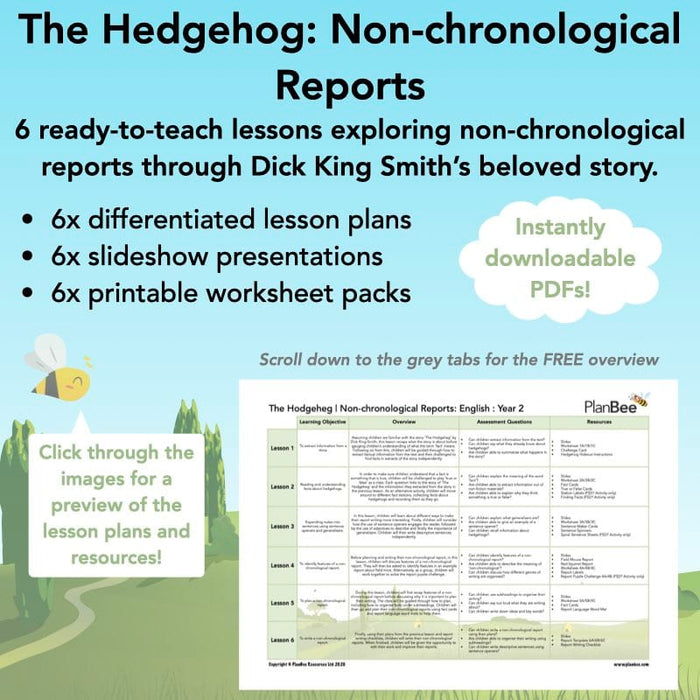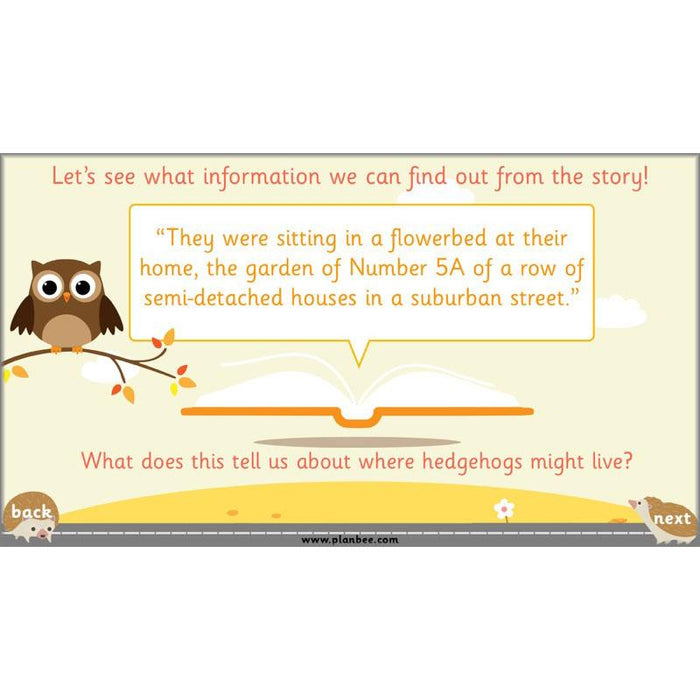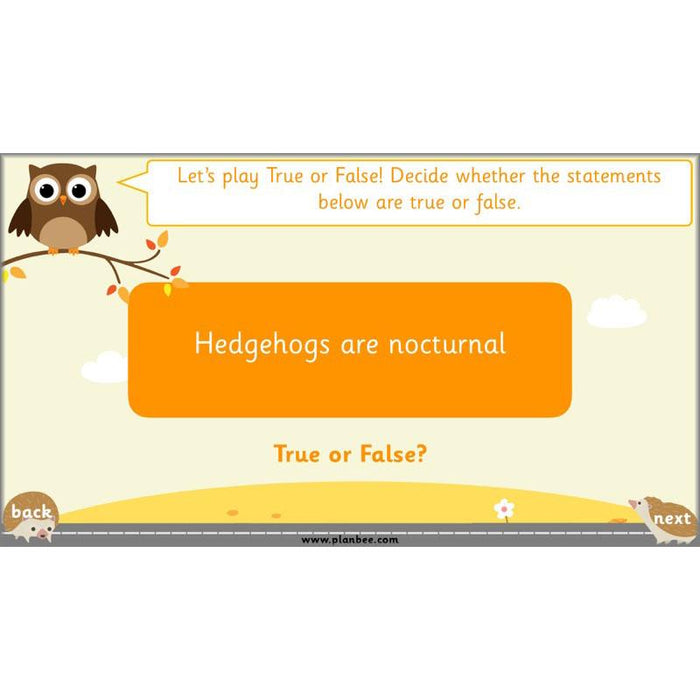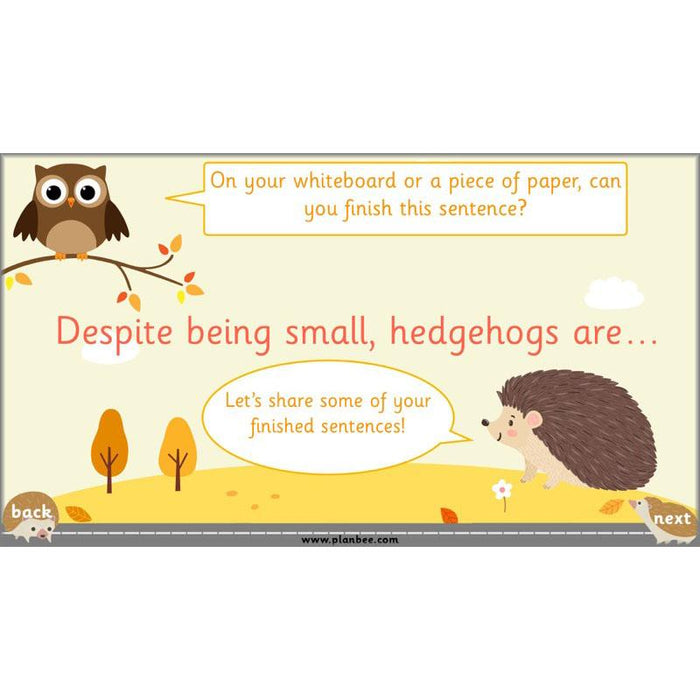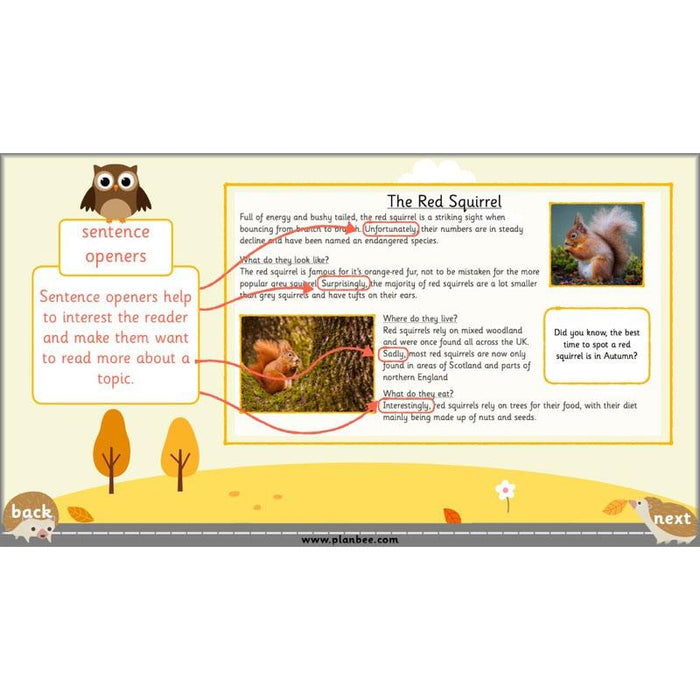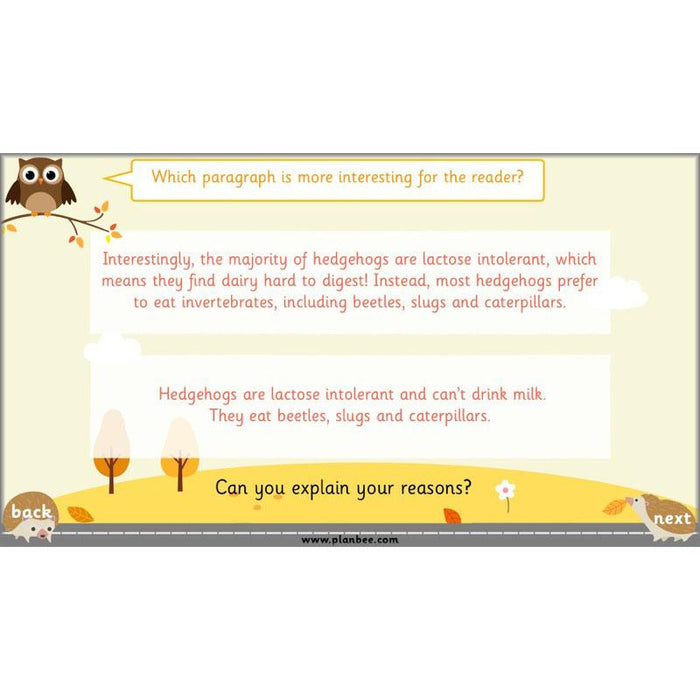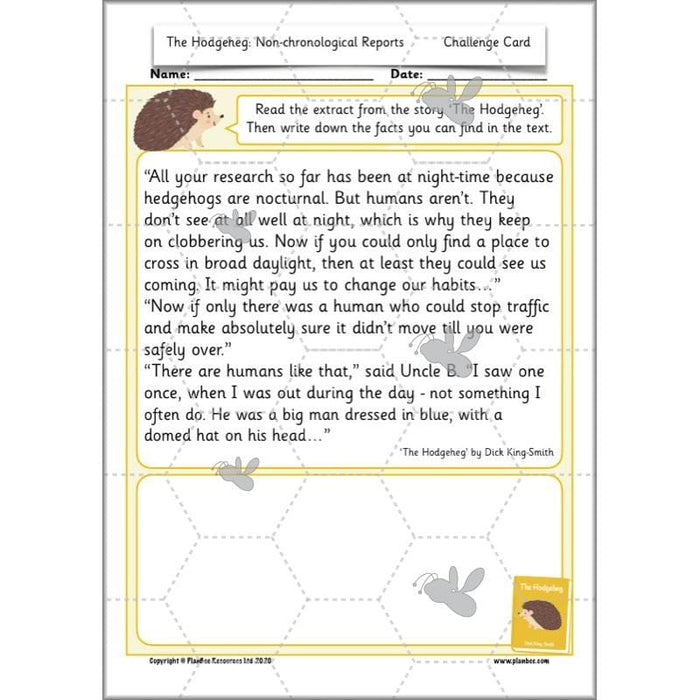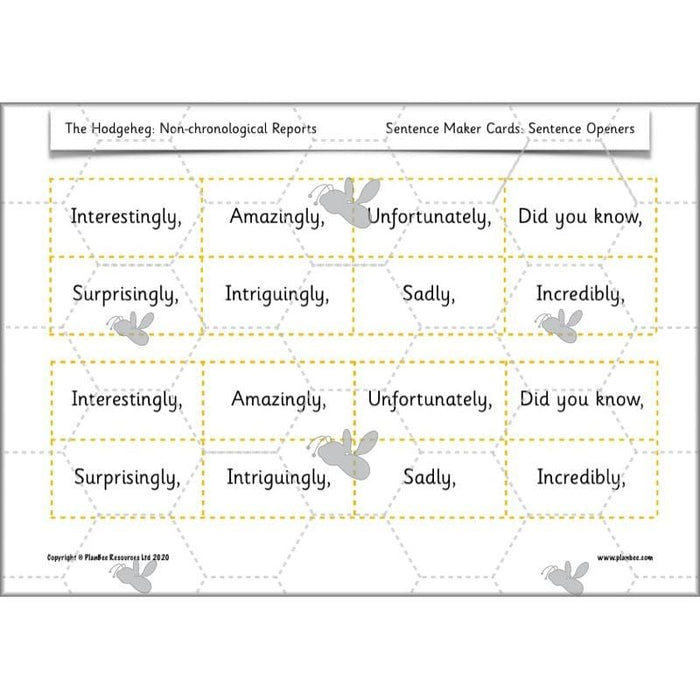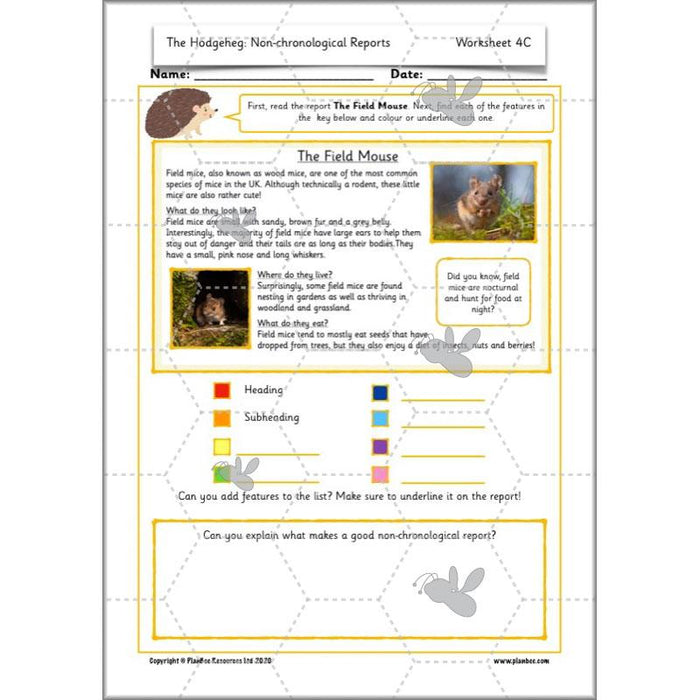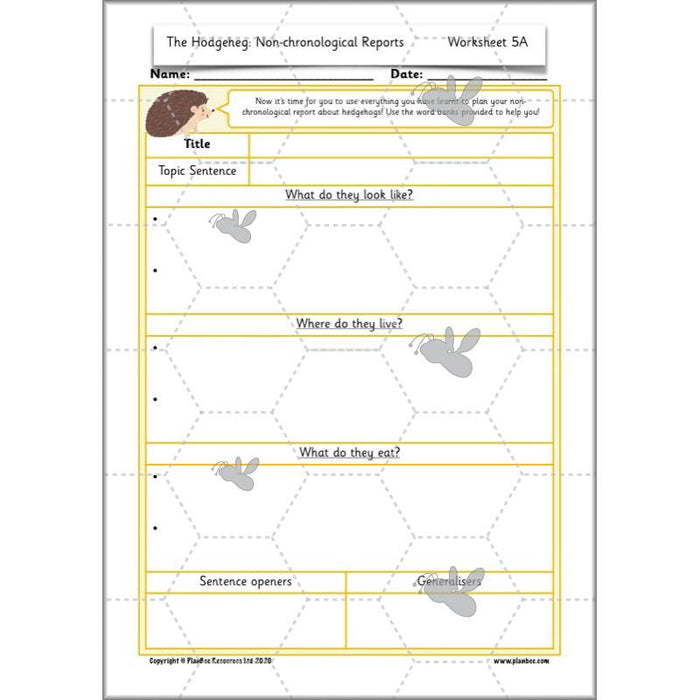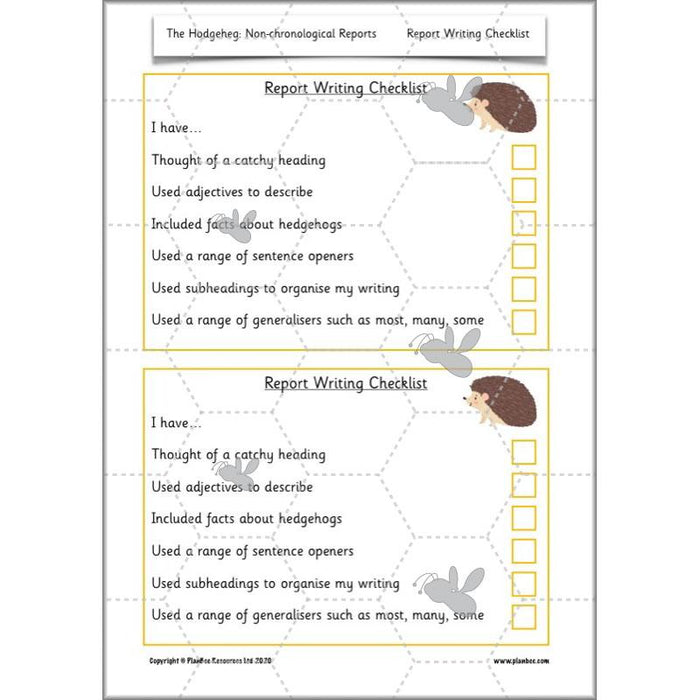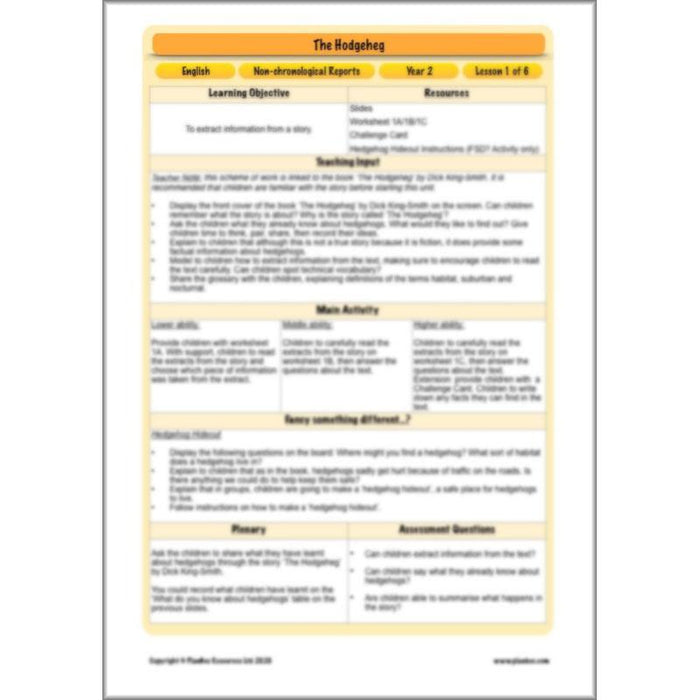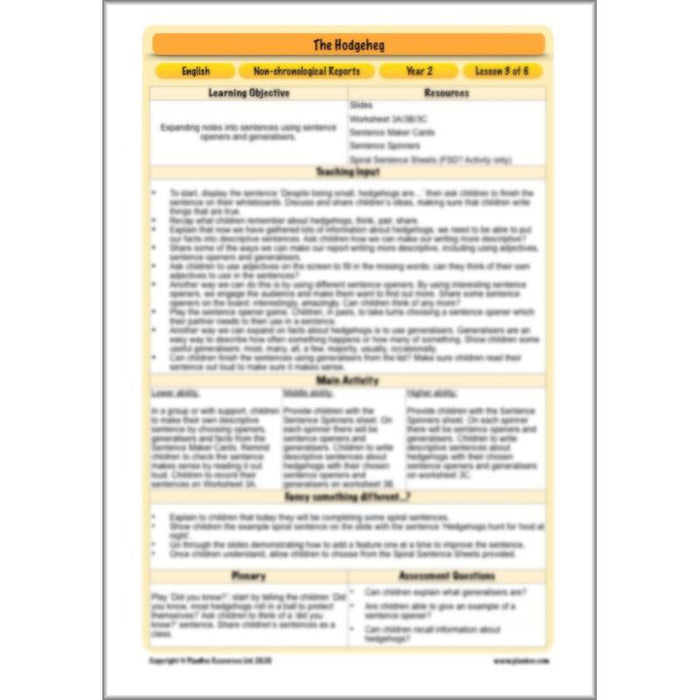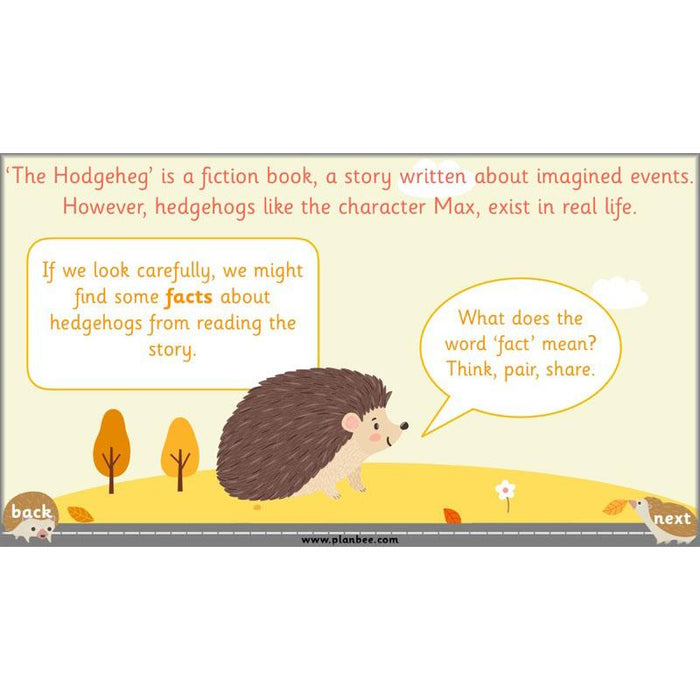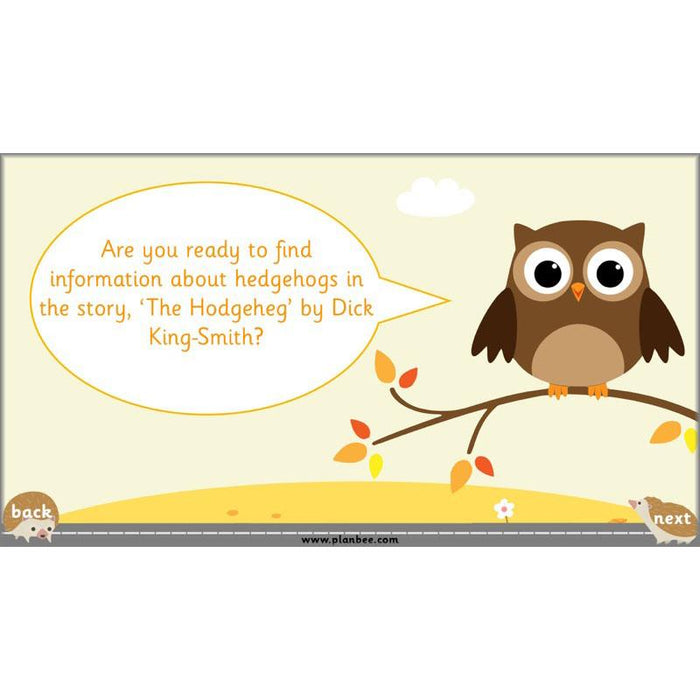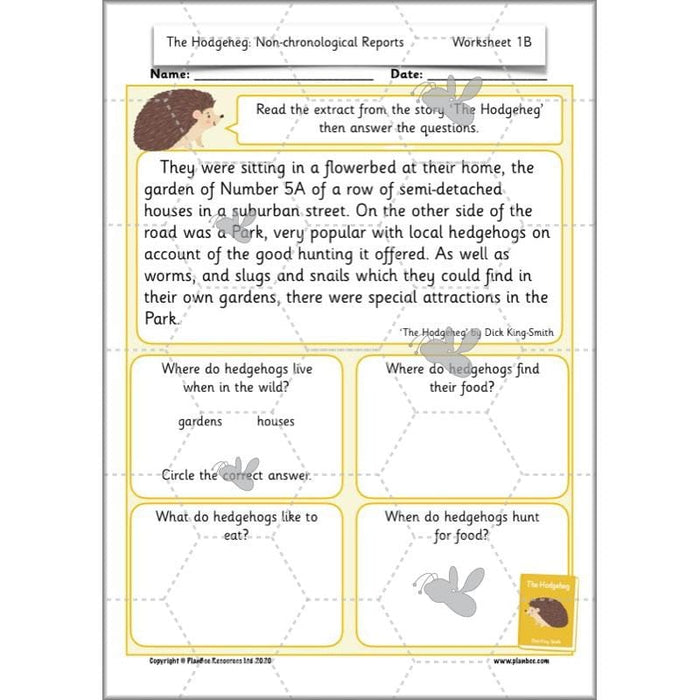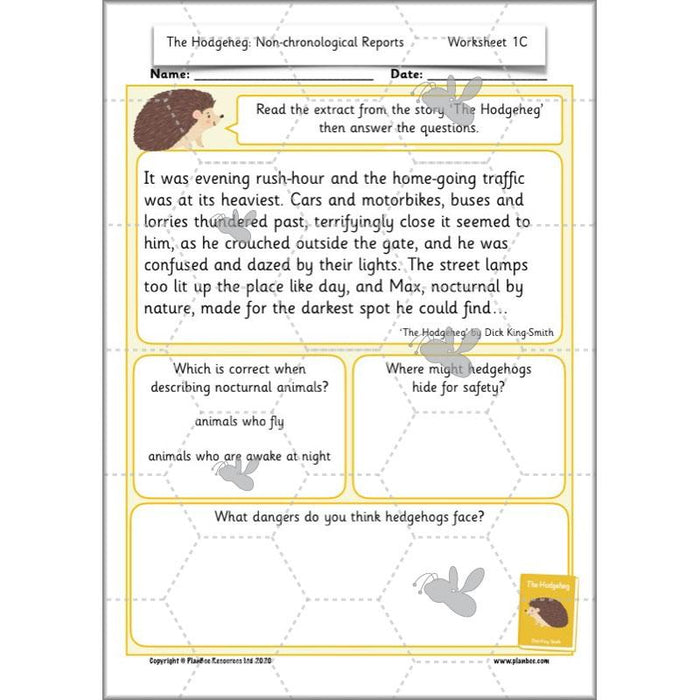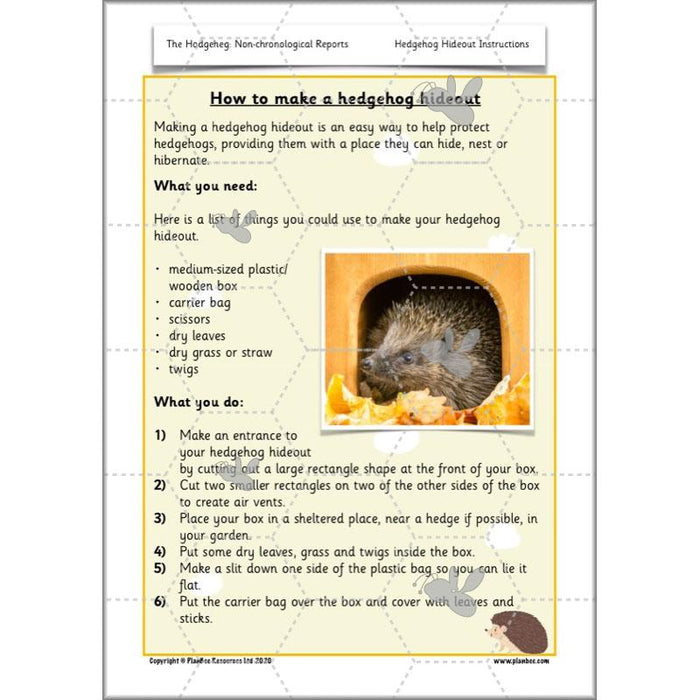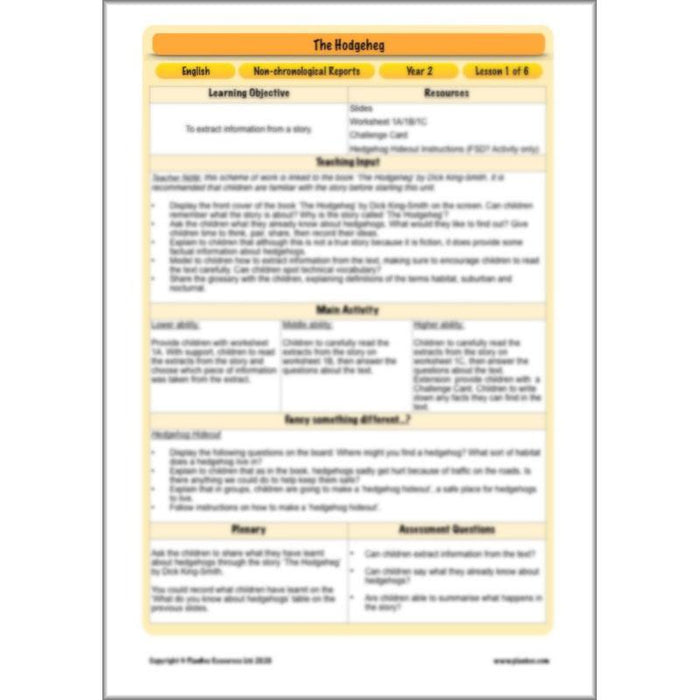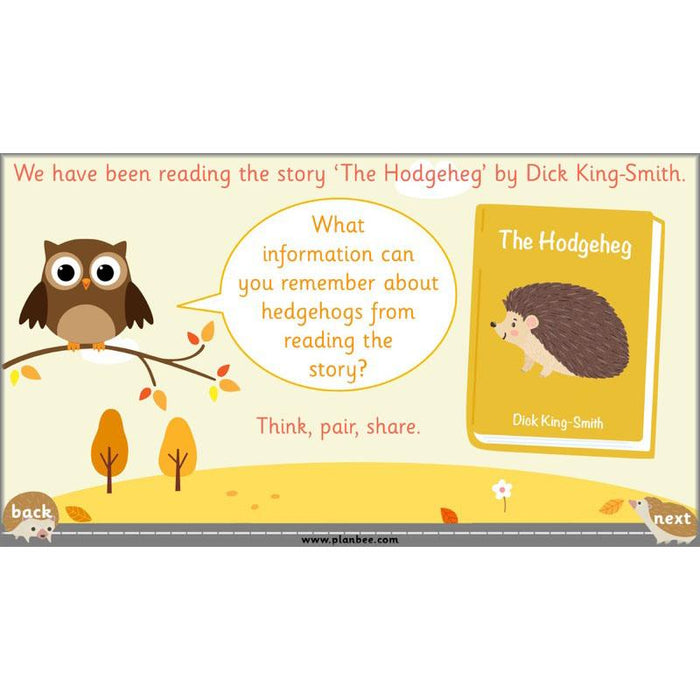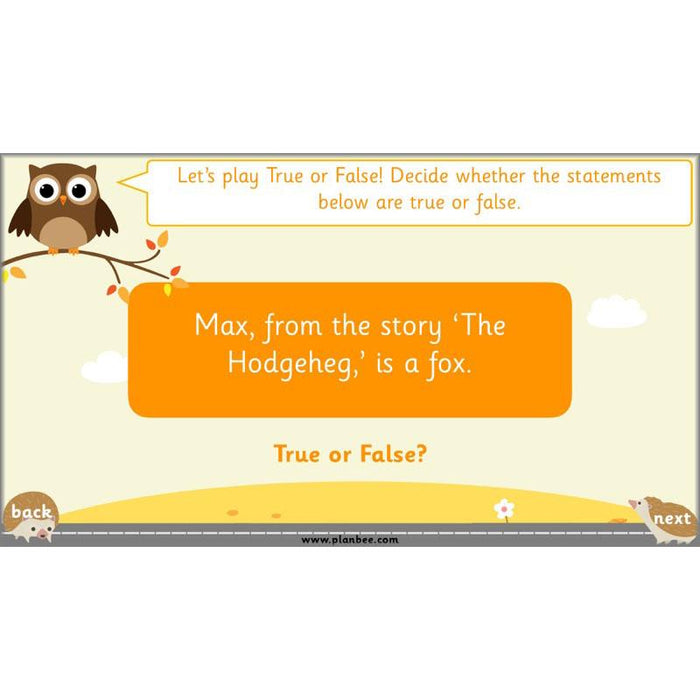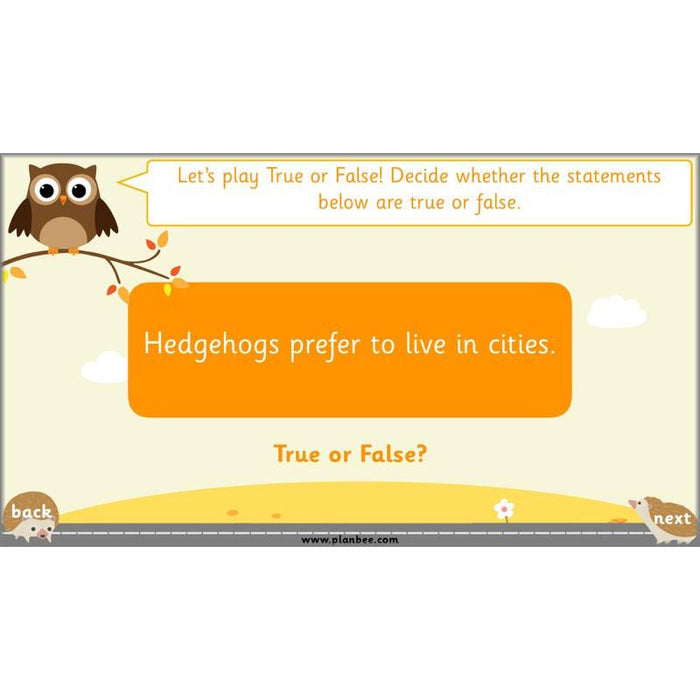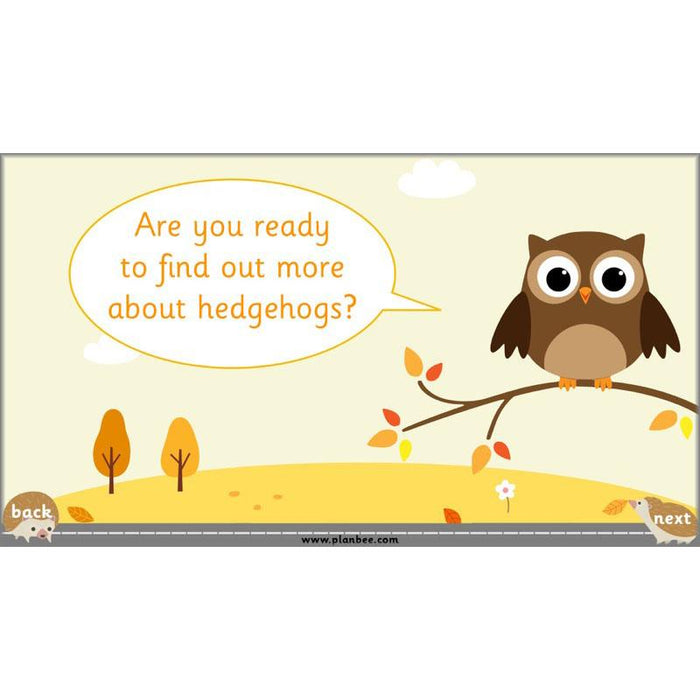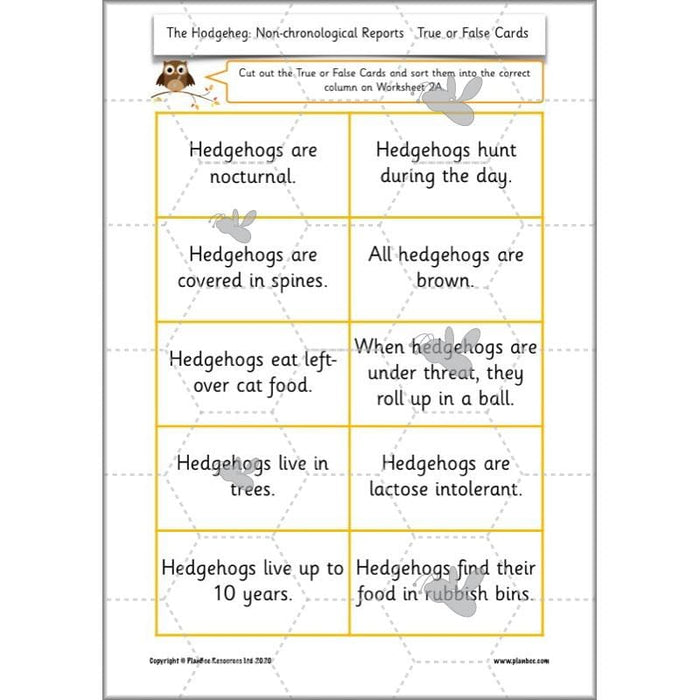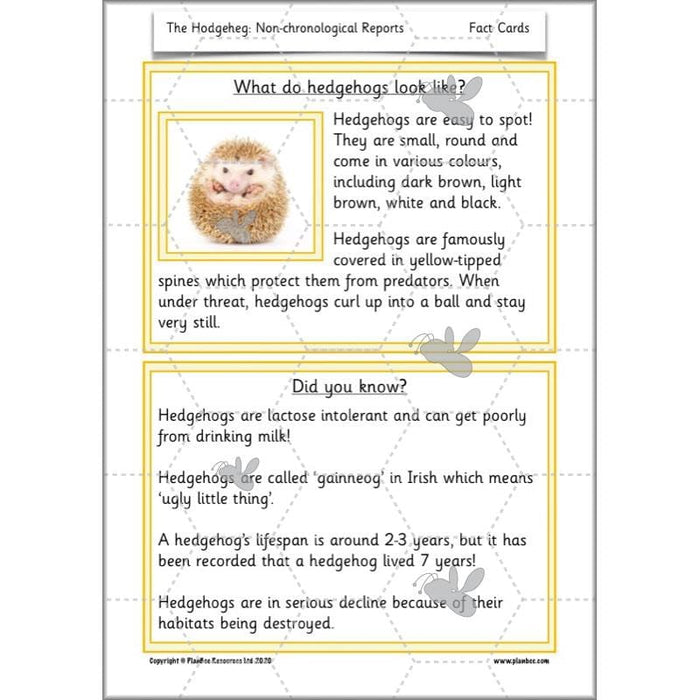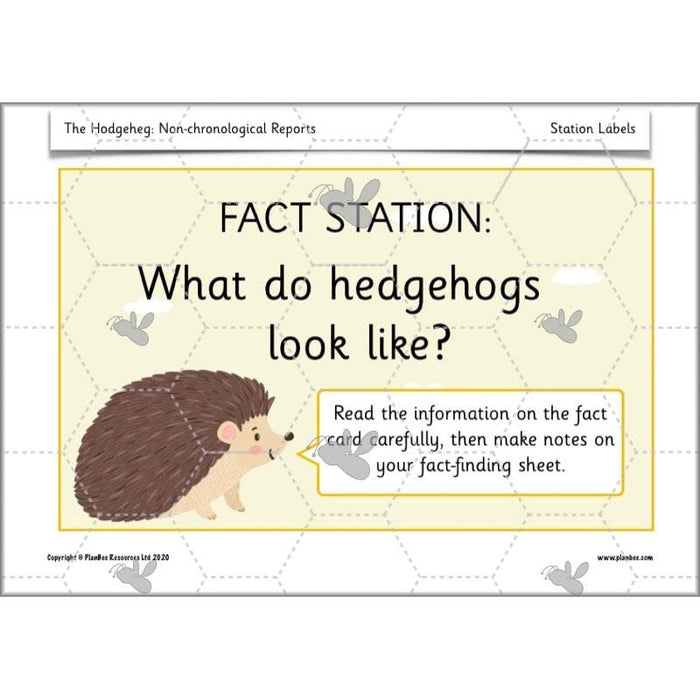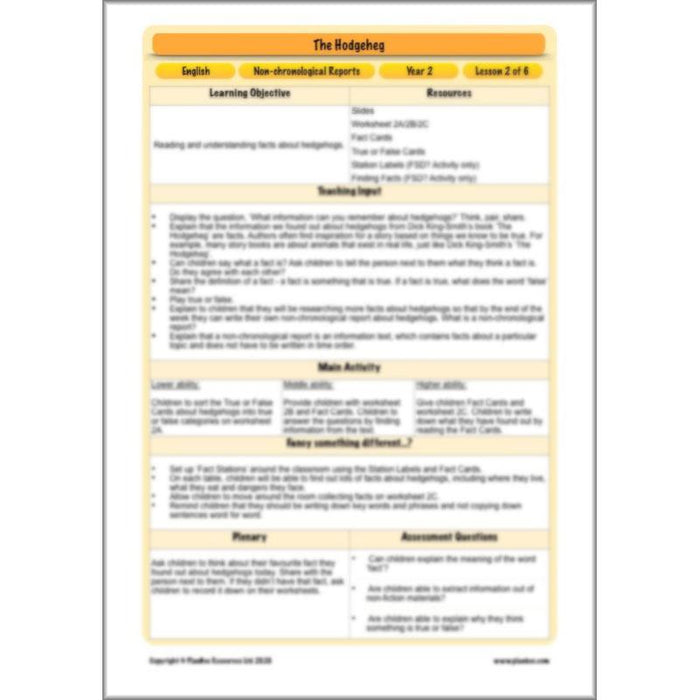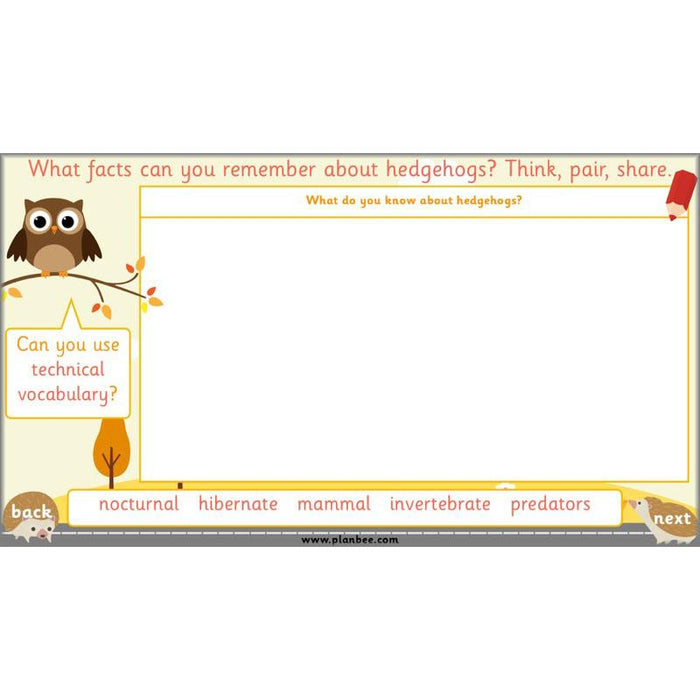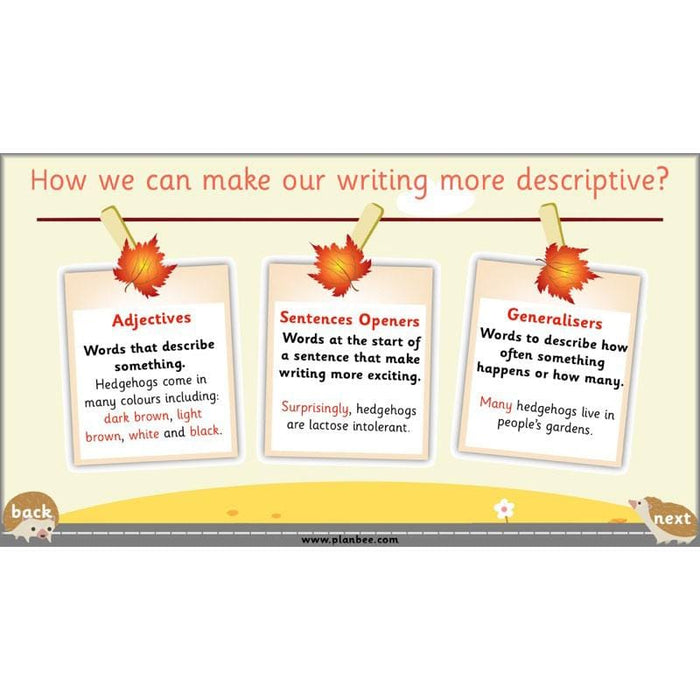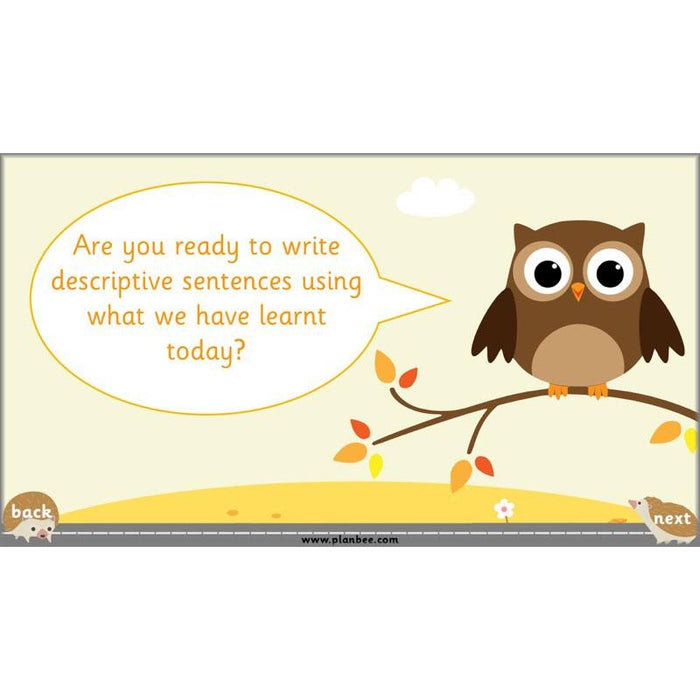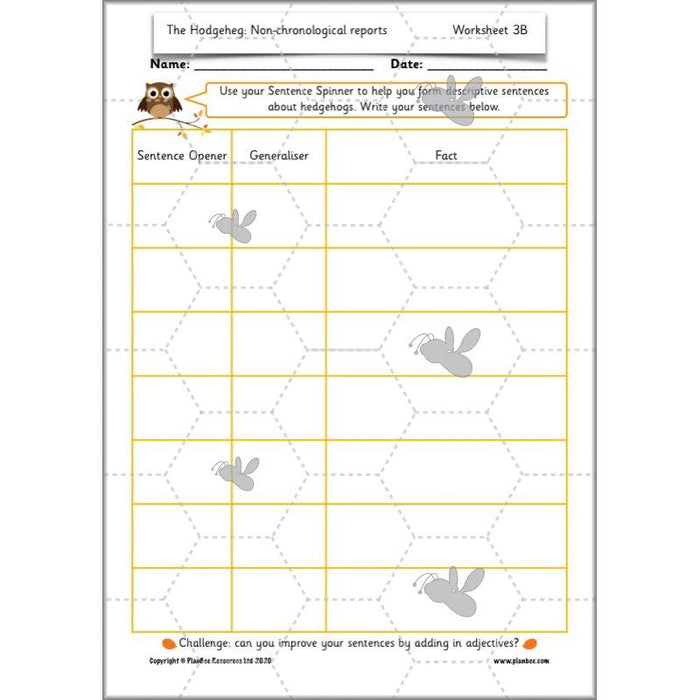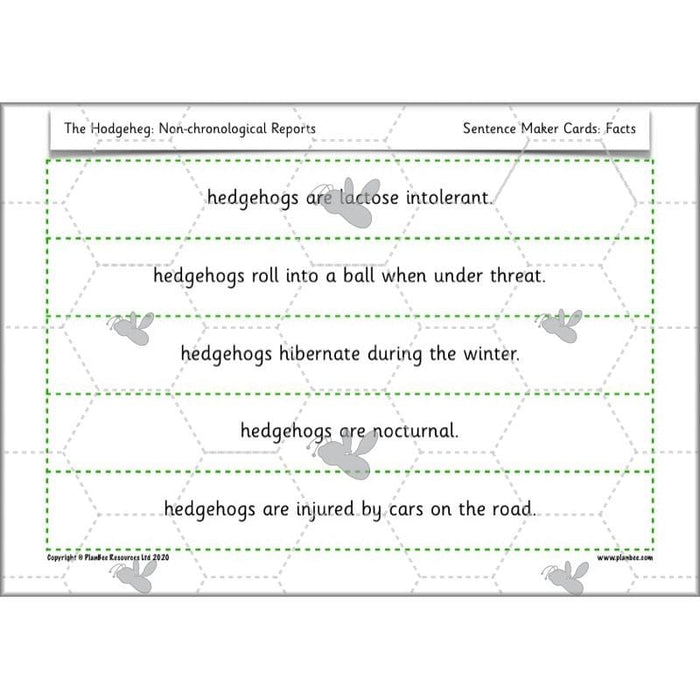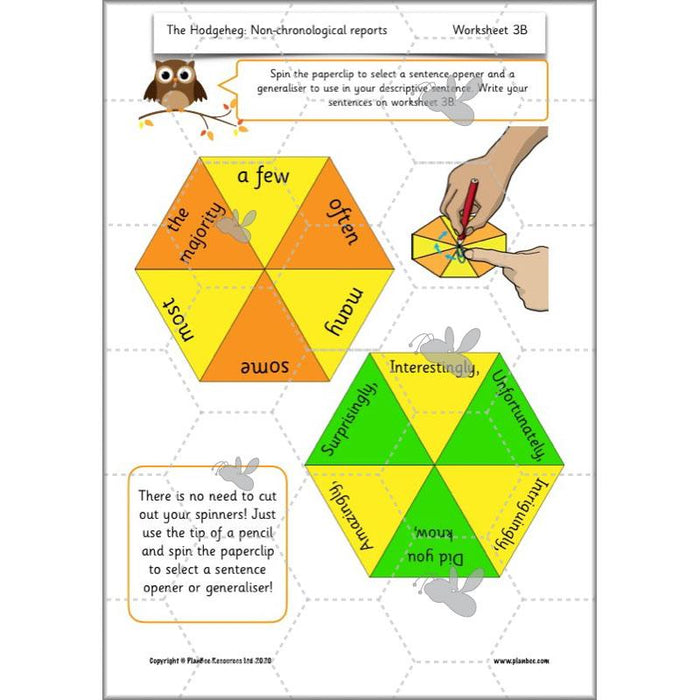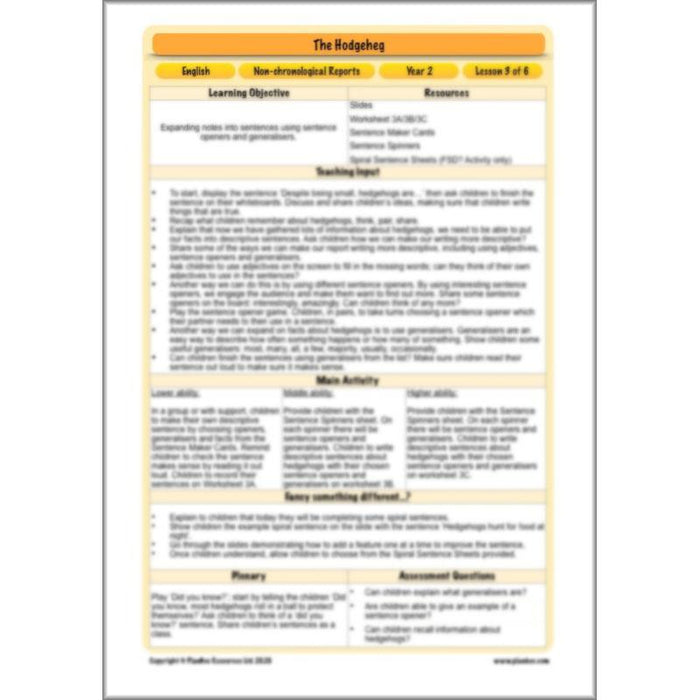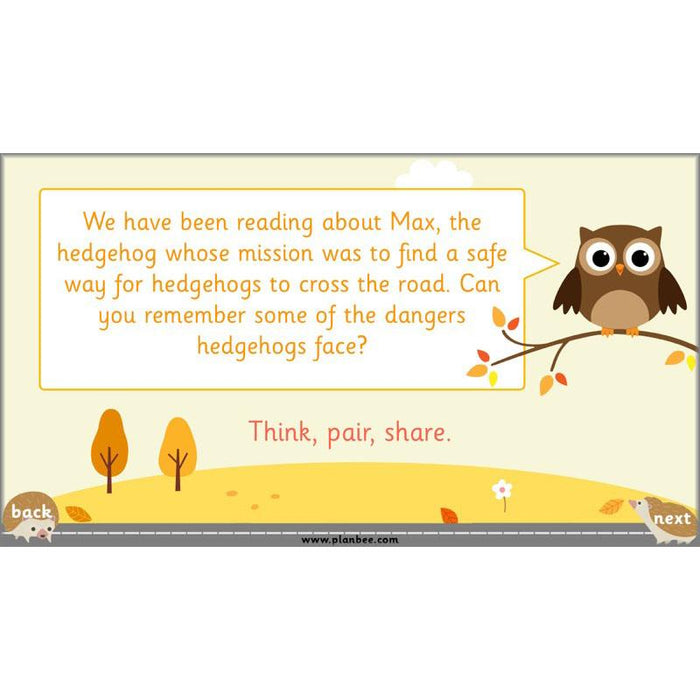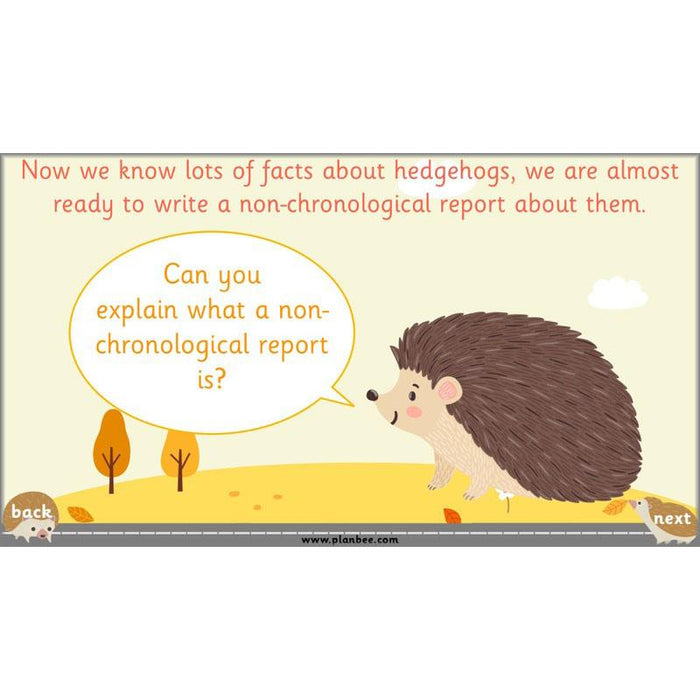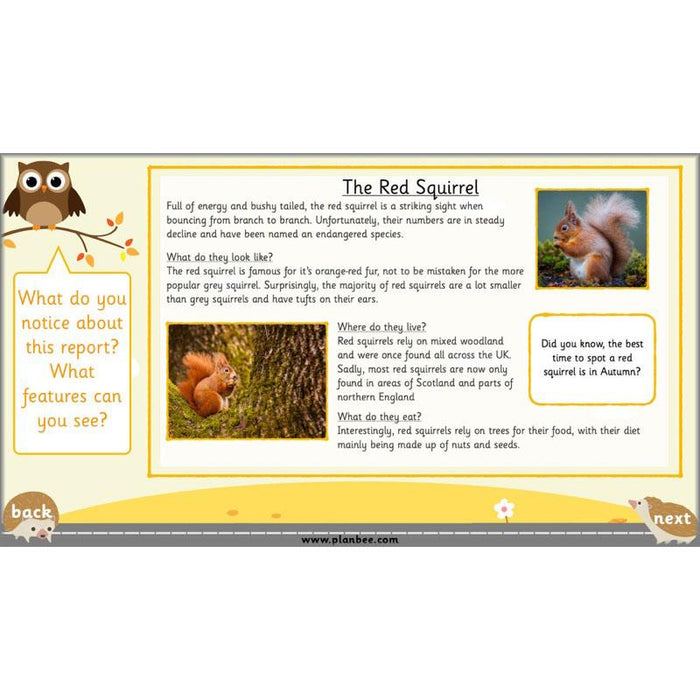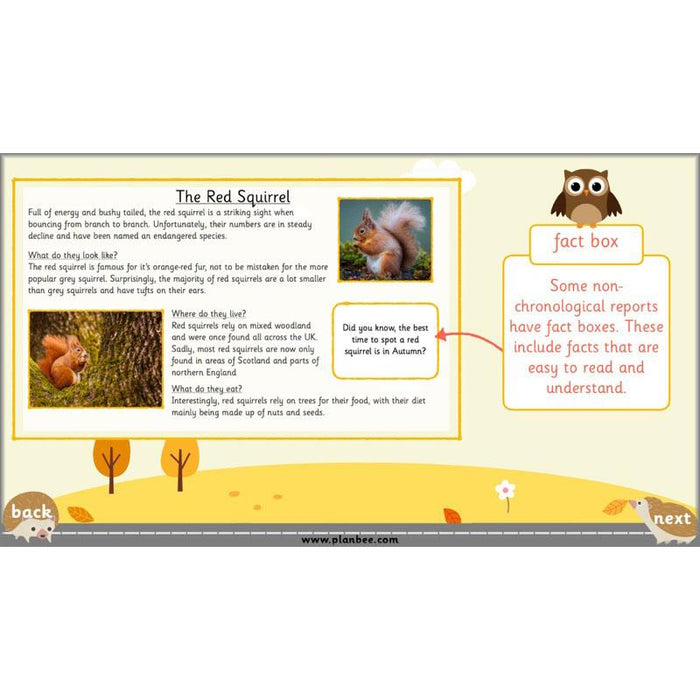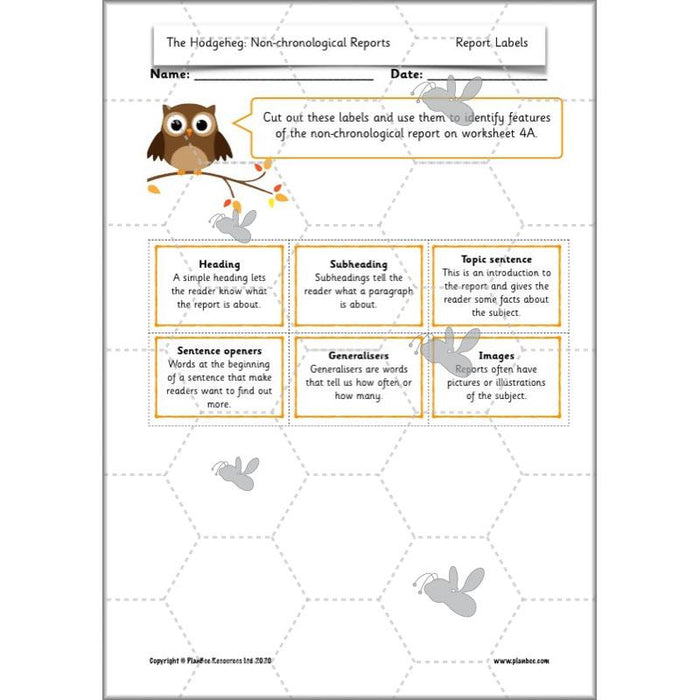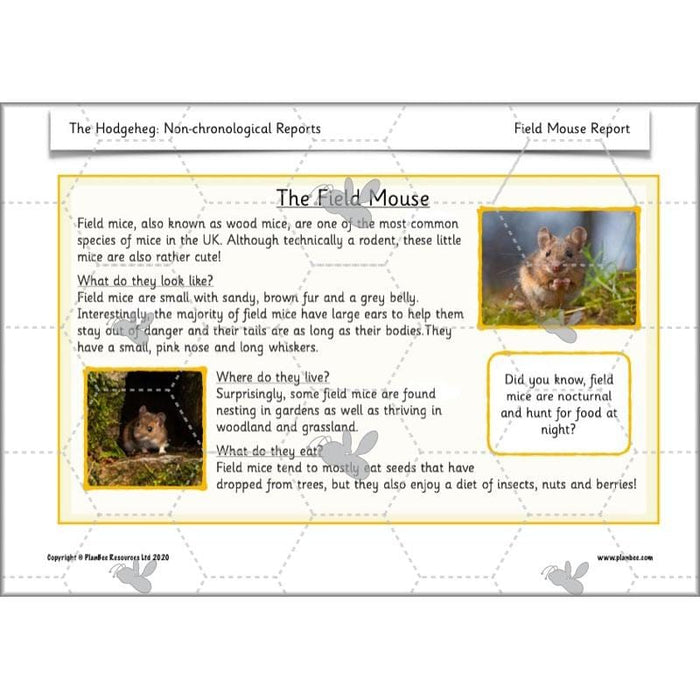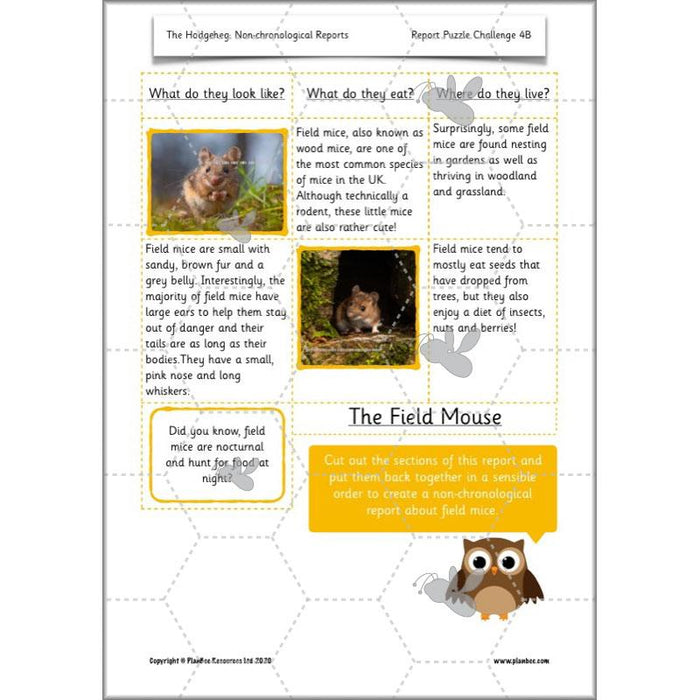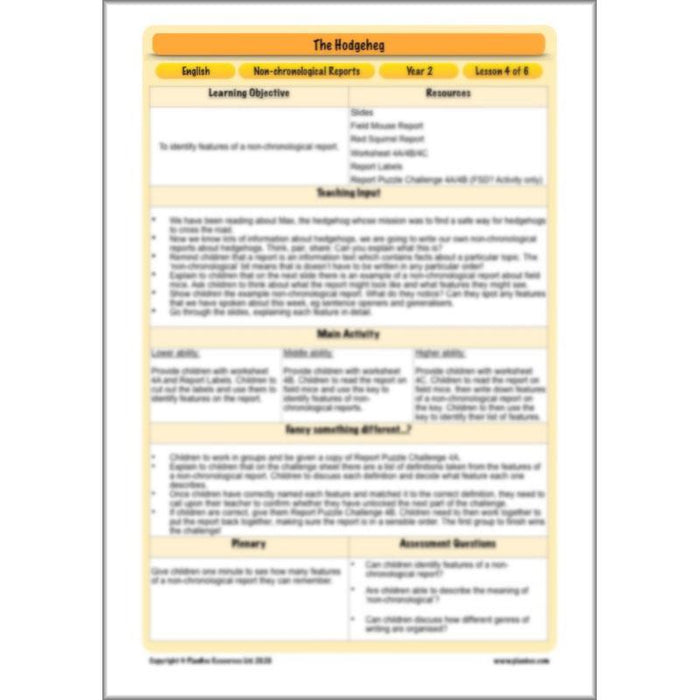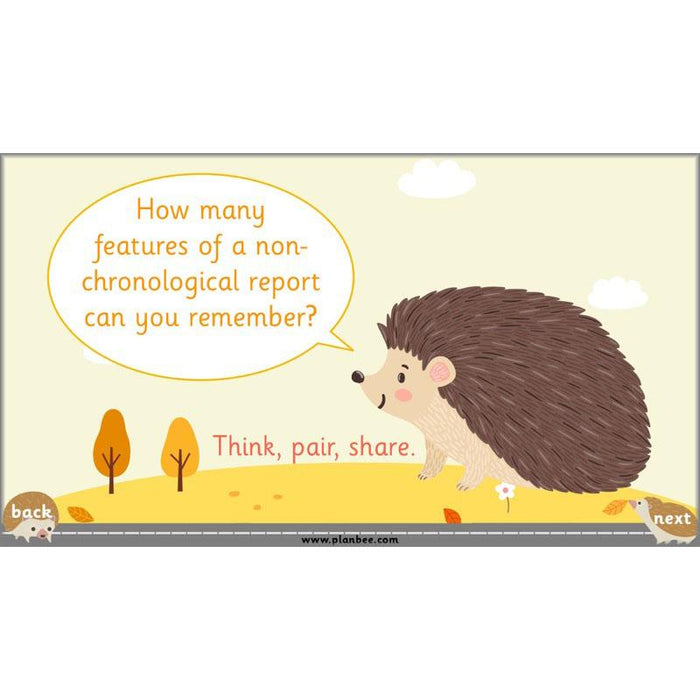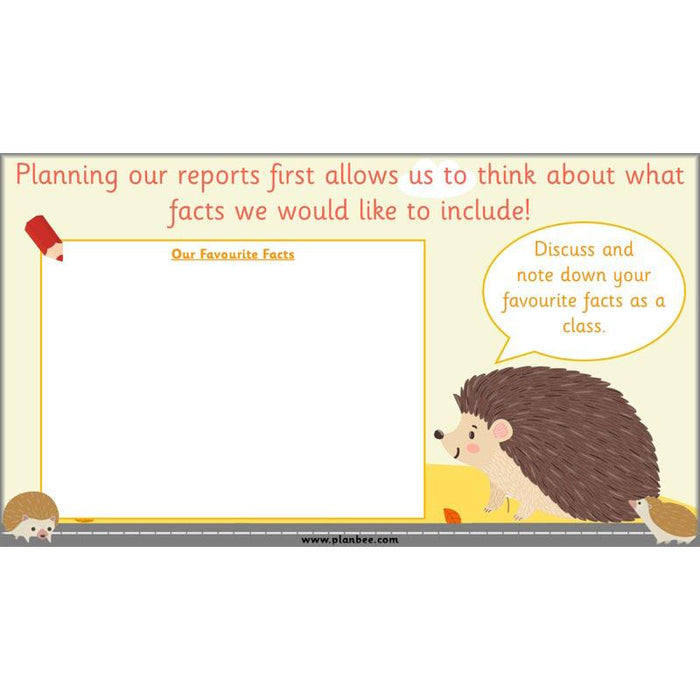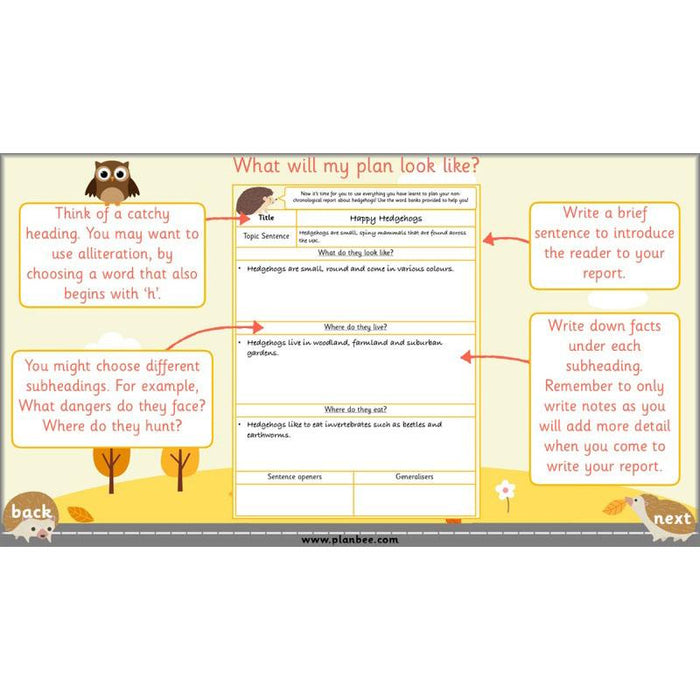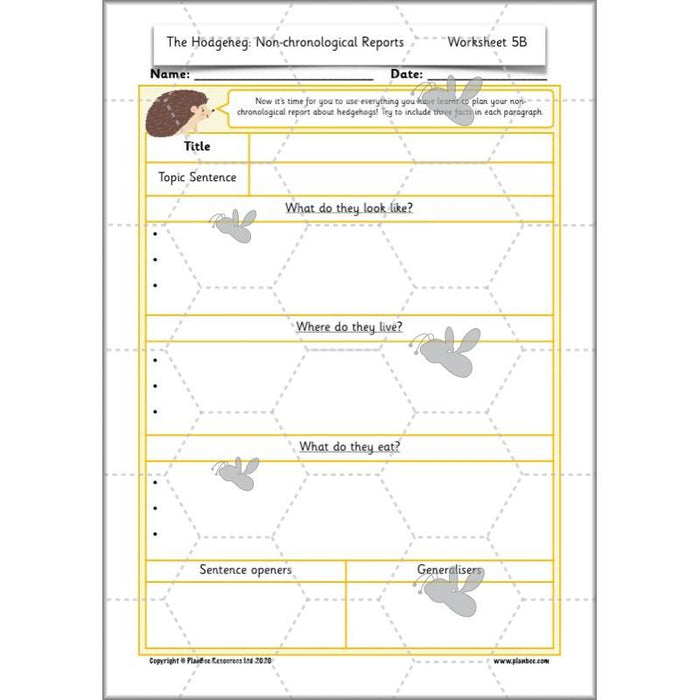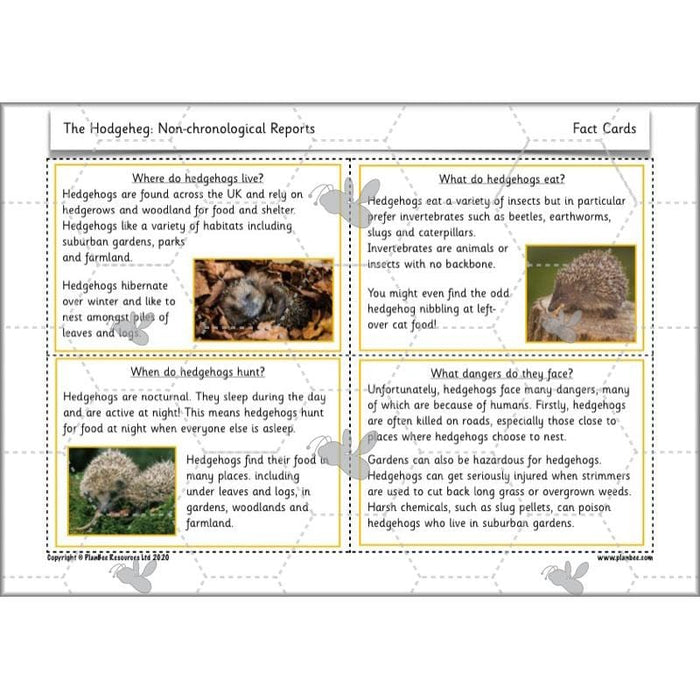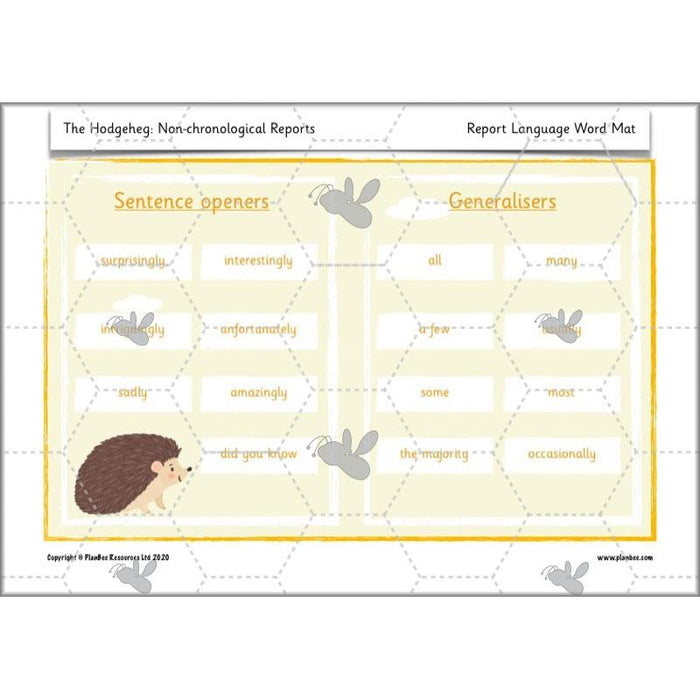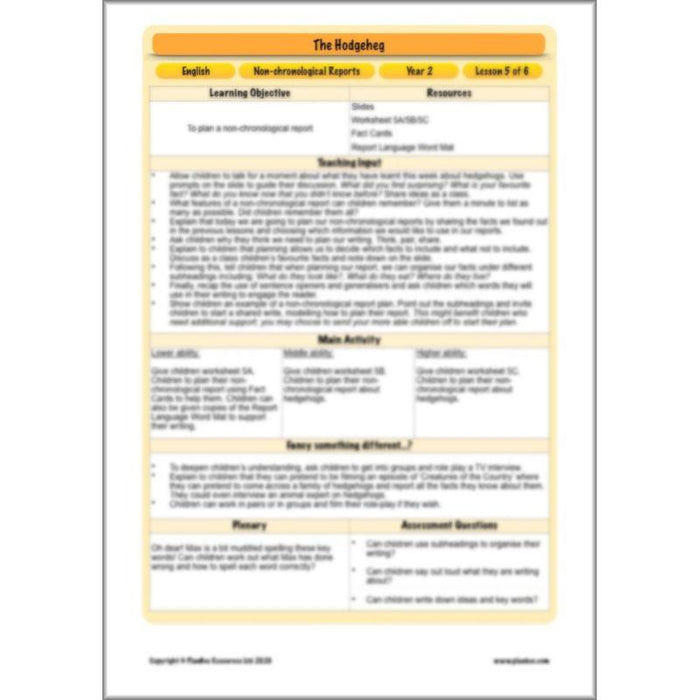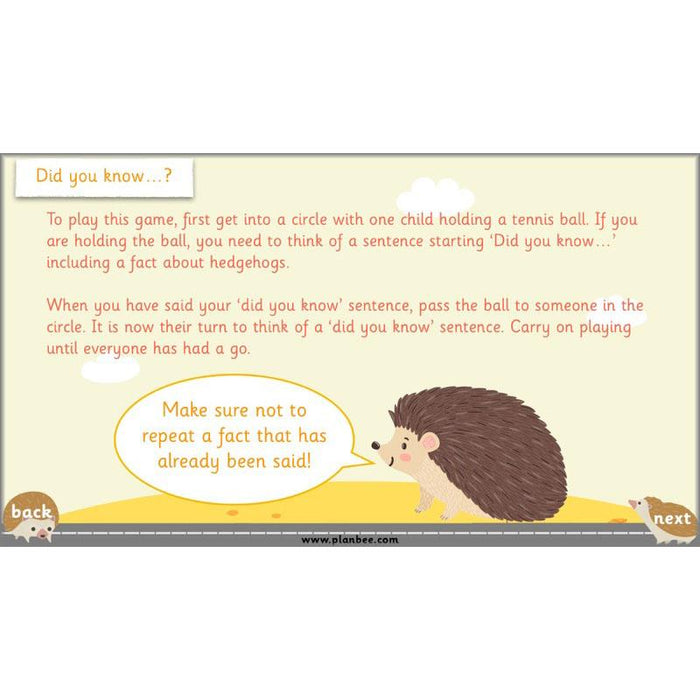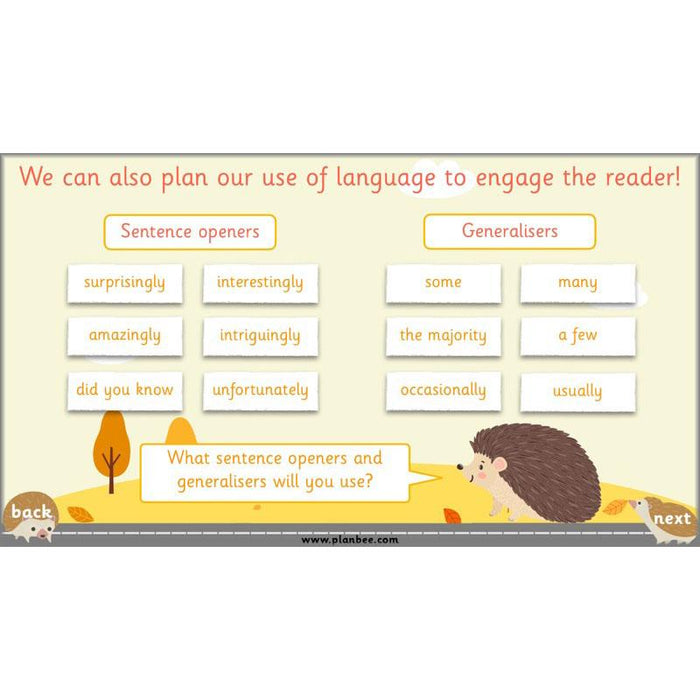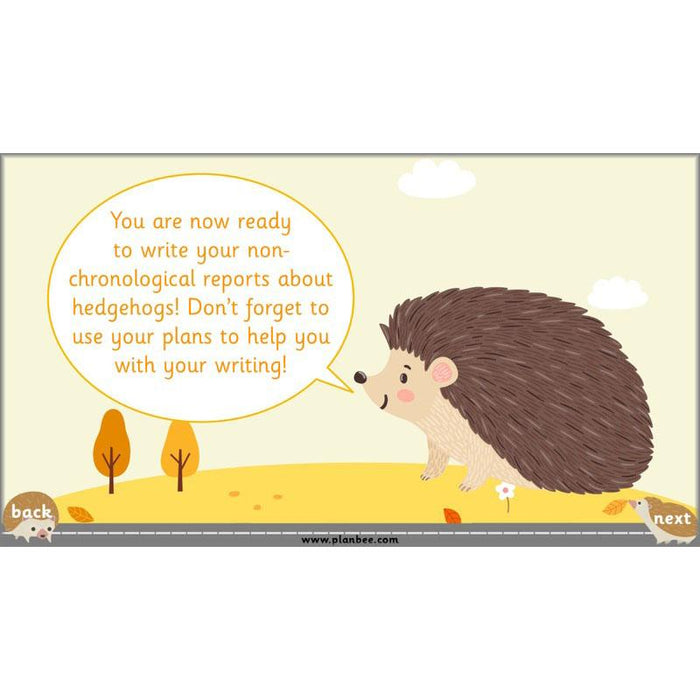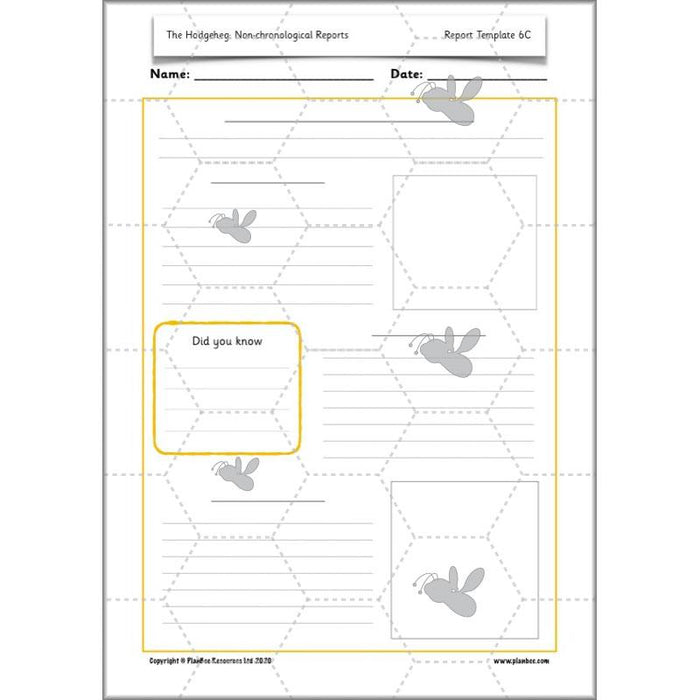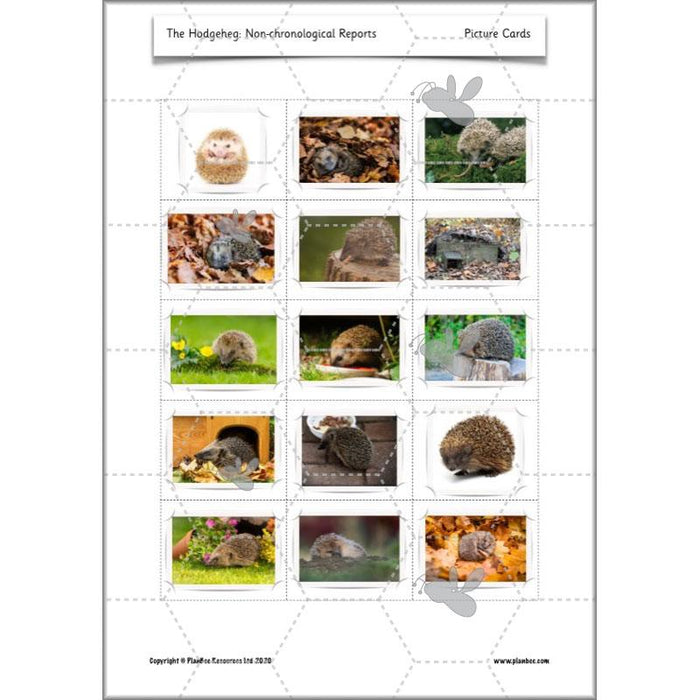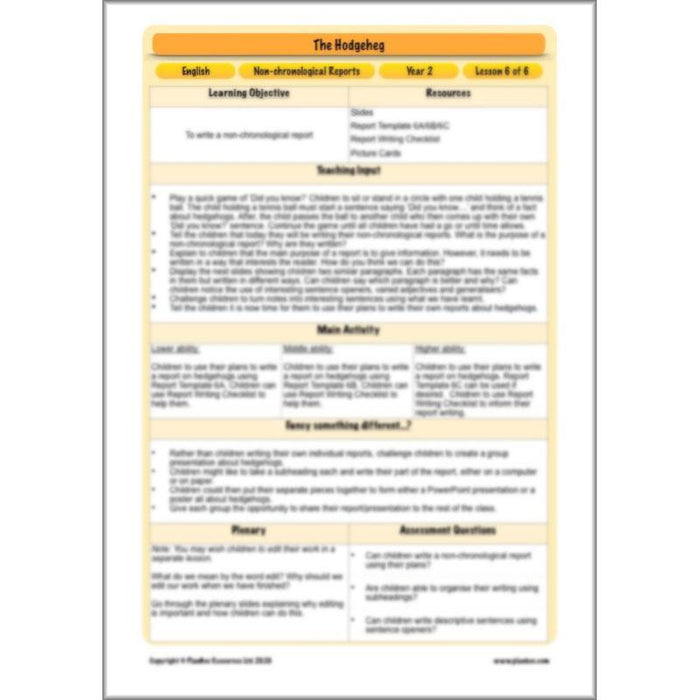#TheCompleteSeries6lessons
As the lessons progress, your class will build up the skills they need to write their own non-chronological reports on hedgehogs. They will learn how to gather facts, how to plan a report, and finally write a report independently.
This six-lesson non-chronological reports year 2 planning pack provides everything you need to deliver these fun and engaging lessons, including a detailed lesson plan, slideshows for the teaching inputs, differentiated activities, and a range of printable teaching resources.
Please be aware that, for copyright purposes, we are unable to provide the full text for this scheme of work. Extracts are provided where appropriate.
#Lesson1ExtractingInformation
Using this Extracting Information KS1 Lesson Pack, inspired by Dick King-Smith's 'The Hodgeheg', children will briefly summarise the story and discuss what they already know about hedgehogs.
Your Year 2 children will then be guided through how to extract information from the text, considering what in the story is factual and what is fiction. Children will then independently find information in extracts of the story and record what they have learnt about hedgehogs.
This Extracting Information KS1 Lesson Pack is ready to teach, with a detailed lesson plan, engaging slides for input, and differentiated activities, all at the click of a button!
What's included:
- Lesson Plan
- Slides
- Activity ideas
- Challenge cards
- Hedgehog hideout instructions
#Lesson2GatheringFacts
In this Gathering Facts KS1 Lesson Pack, children will first revisit their understanding of facts as something that is true before playing 'true or false' linked to the information they extracted from the text in the previous lesson.
Children will then be provided with various information about hedgehogs. Your Year 2 children will need to read the information carefully and note down facts that they have learnt. As an alternative activity, children will move around to different fact stations, collecting facts about hedgehogs and recording them as they go.
Download this Gathering Facts KS1 Lesson Pack today! With planning, differentiated activities and slides for your input, this lesson pack has everything you need to teach a successful English lesson.
What's included:
- Lesson Plan
- Slides
- Activity ideas
- Fact cards
- True or false cards
- Fact station labels
#Lesson3SentenceOpenersandGeneralisers
In this third lesson of this series, your class will learn how to make their report writing more exciting for the reader.
Firstly, children will look at how using a range of sentence openers can encourage the reader to want to find out more about the subject. They will form a list of sentence openers as a class that will then help to inform their report writing at a later date. Children will also be encouraged to use adjectives to add more detail into their writing, as well as generalisers to describe how many or how often.
This lesson pack has everything you need to support children's writing, including planning, differentiated activities, and slides for input.
What's included:
- Lesson Plan
- Slides
- Activity ideas
- Sentence maker cards
- Sentence spinners
#Lesson4FeaturesofaNonchronologicalReport
Before planning and writing, your Year 2 class will explore the features of non-chronological reports in the fourth lesson of this series.
They will explore features and the purpose of these through examples of non-chronological reports, including reports on field mice and red squirrels. As an alternative activity, children will work together to solve the report puzzle challenge, first by matching up features to their definitions and then by arranging a muddled report into a logical order.
A detailed lesson plan, a slideshow for the teaching input, and differentiated worksheets are all included in this Features of a Non-chronological Report KS1 English planning pack!
What's included:
- Lesson Plan
- Slides
- Activity ideas
- Non-chronological report examples
- Report labels
- Challenge cards
#Lesson5PlanningaNonchronologicalReport
Now that your KS1 class knows all sorts of facts about hedgehogs, it’s time to plan their non-chronological reports! The slides will remind children of the features of a non-chronological report and discuss what they need to include in their plan.
During their independent learning time, they can then arrange the information they have gathered into paragraphs (with sub-headings), plan what sentence openers and generalisers they will use, and prepare to write their non-chronological reports about hedgehogs.
This Planning a Non-chronological Report Year 2 English pack includes a detailed lesson plan, an engaging set of slides for the teaching input, and differentiated resources.
What's included:
- Lesson Plan
- Slides
- Activity ideas
- Fact cards
- Word mat
#Lesson6WritingaNonchronologicalReport
In the final lesson in this six-part series, your class will be writing non-chronological reports on hedgehogs, based on the plan they created in the previous lesson.
The included slideshow presentation for the teaching input will show them two paragraphs, both containing the same facts but with one being more detailed than the other. Children will need to decide which is better, making sure to look carefully for features of a non-chronological report. Children will then write their reports using the downloadable non-chronological report checklists to help them.
This Writing a Non-chronological Report Year 2 Lesson Pack contains everything you need to teach a successful English lesson, including differentiated report templates and non-chronological report checklists to support their writing.
What's included:
- Lesson Plan
- Slides
- Activity ideas
- Checklist
- Differentiated worksheets
Free Overview (Medium-Term Plan)
Download a free overview to support your teaching of this scheme of work.
Free Assessment Grid
Download a free, editable assessment grid to support your teaching of this scheme of work.
Curriculum Objectives covered
Reading - Comprehension Objectives:
- listening to, discussing and expressing views about a wide range of contemporary and classic poetry, stories and non-fiction at a level beyond that at which they can read independently
- discussing the sequence of events in books and how items of information are related
- becoming increasingly familiar with and retelling a wider range of stories, fairy stories and traditional tales
- discussing and clarifying the meanings of words, linking new meanings to known vocabulary
- drawing on what they already know or on background information and vocabulary provided by the teacher
- answering and asking questions
- participate in discussion about books, poems and other works that are read to them and those that they can read for themselves, taking turns and listening to what others say
- explain and discuss their understanding of books, poems and other material, both those that they listen to and those that they read for themselves
Writing - Composition Objectives:
- writing about real events
- writing for different purposes
- planning or saying out loud what they are going to write about
- writing down ideas and/or key words, including new vocabulary
- encapsulating what they want to say, sentence by sentence
- evaluating their writing with the teacher and other pupils
- re-reading to check that their writing makes sense and that verbs to indicate time are used correctly and consistently, including verbs in the continuous form
- proof-reading to check for errors in spelling, grammar and punctuation [for example, ends of sentences punctuated correctly]
- read aloud what they have written with appropriate intonation to make the meaning clear
Writing - Spelling, Punctuation and Grammar Objectives:
- sentences with different forms: statement, question, exclamation, command
- expanded noun phrases to describe and specify [for example, the blue butterfly]
English Appendix Objectives:
- Use of the suffixes –er, –est in adjectives and the use of –ly in Standard English to turn adjectives into adverbs
- Expanded noun phrases for description and specification [for example, the blue butterfly, plain flour, the man in the moon]
- How the grammatical patterns in a sentence indicate its function as a statement, question, exclamation or command
